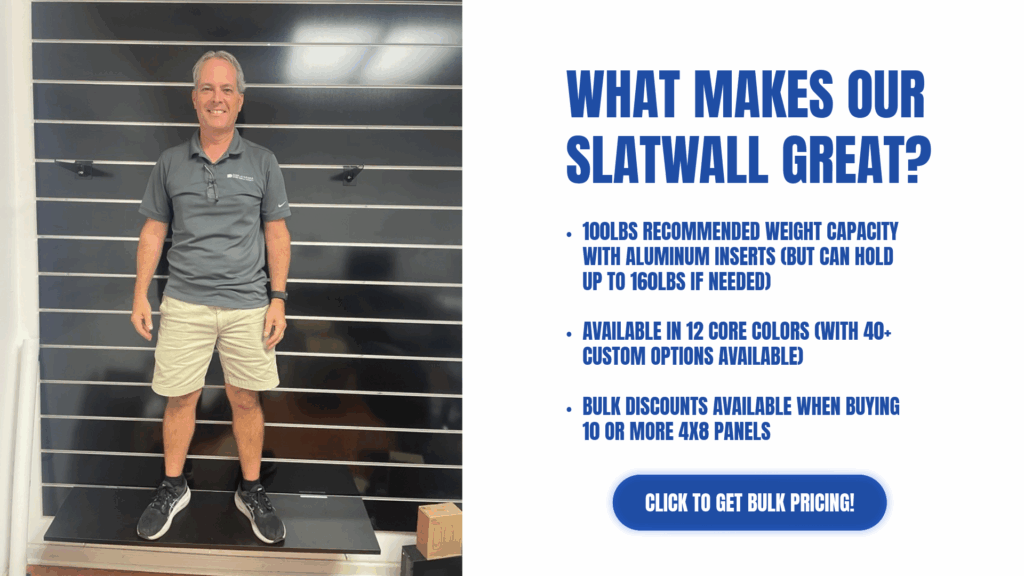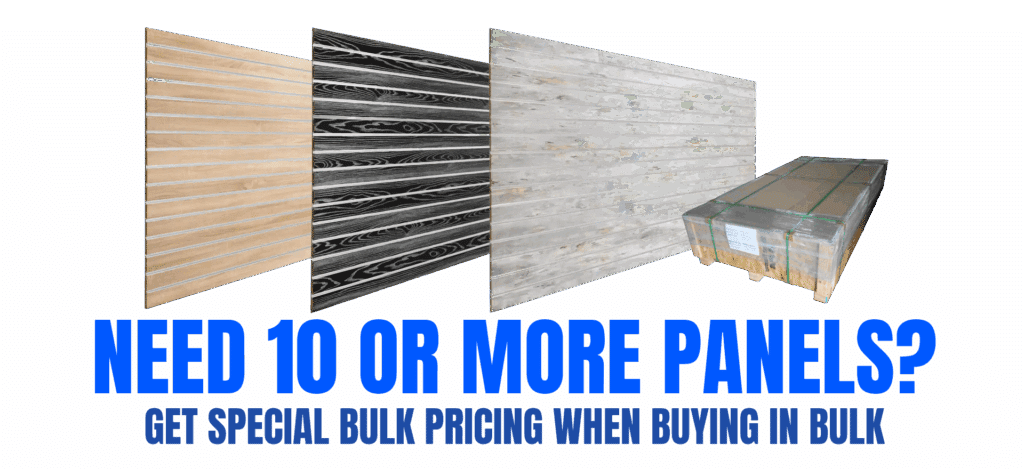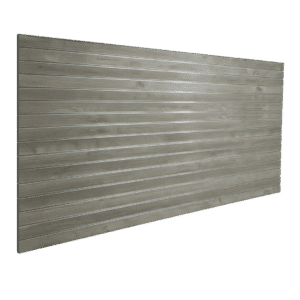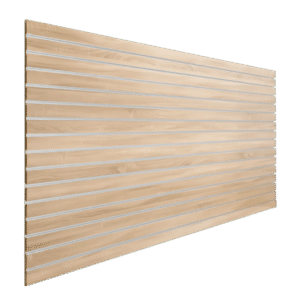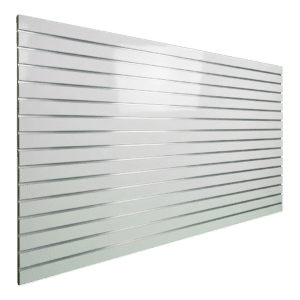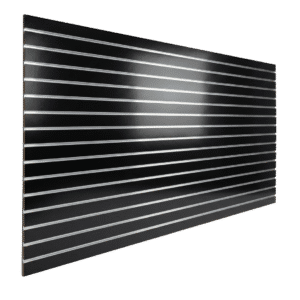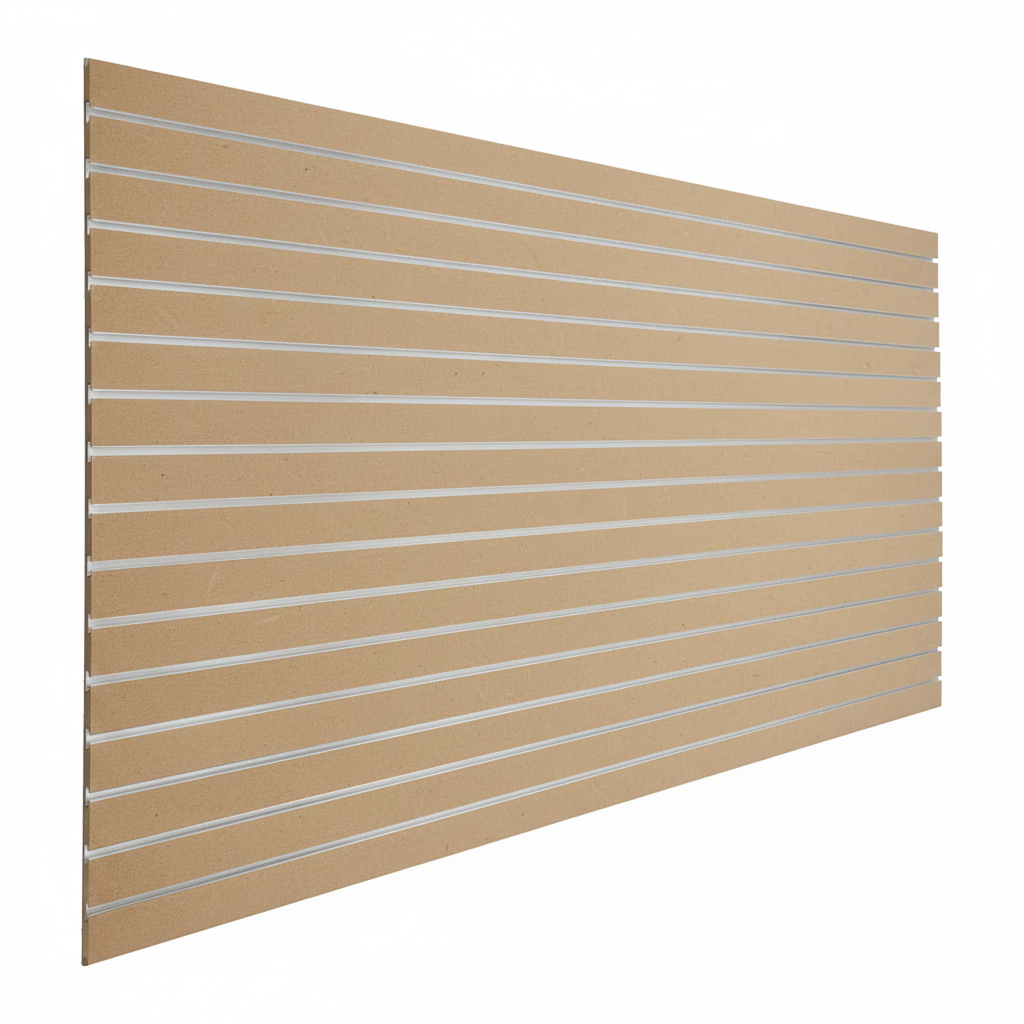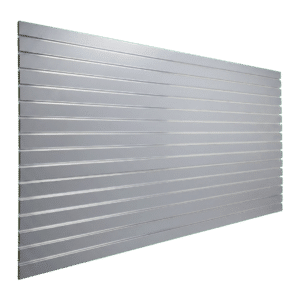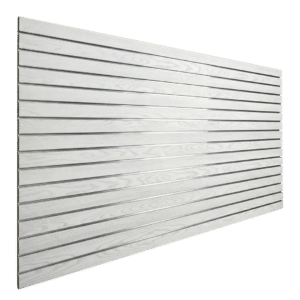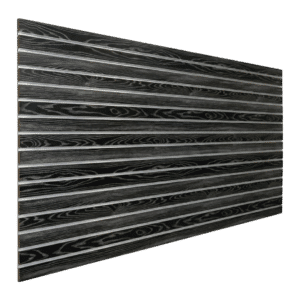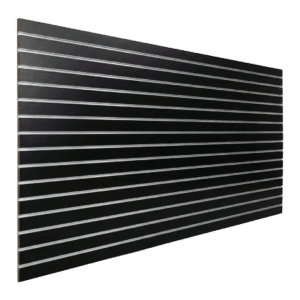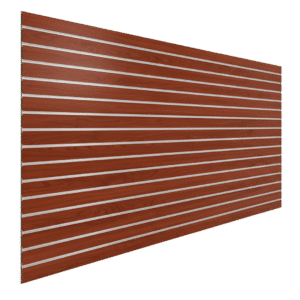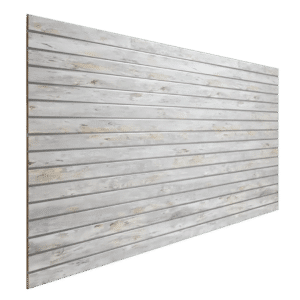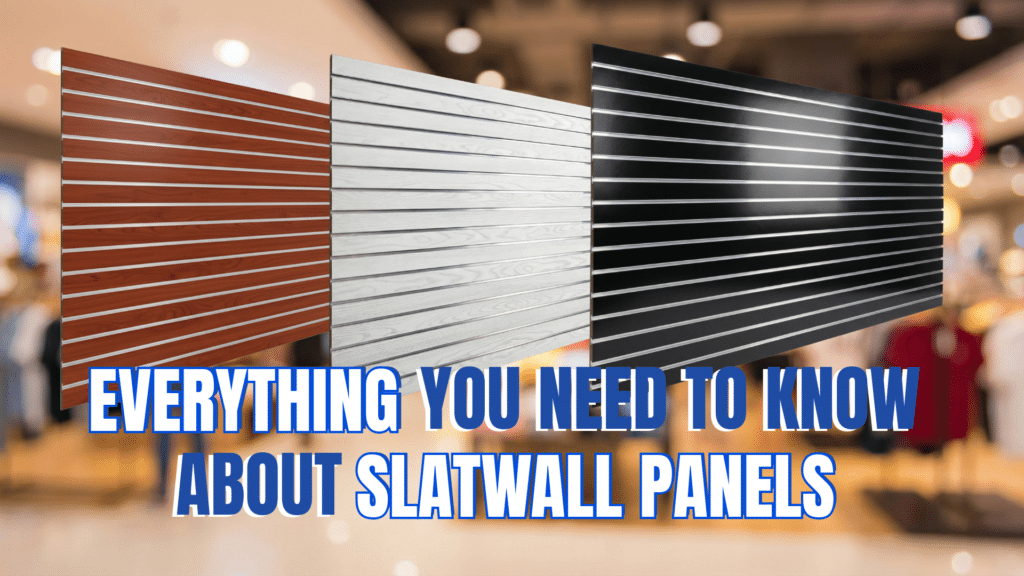
Everything You NEED To Know About Slatwall Panels
Whether you’re just starting your search for the perfect slatwall panels or already have them installed in your retail space or home and still have questions, this guide covers everything you need to know. From installation tips to weight capacity and customization options, we’ll answer the most common, and important questions people have about slatwall panels. Lets dive in!
What are the benefits of using slatwall panels?
Slatwall panels offer a powerful combination of strength, style, and versatility, making them ideal for both commercial and residential spaces. They maximize vertical wall space, keep floors clear, and create adaptable, clean, and organized storage or display areas that help showcase products or household items more effectively.
Storage & Space Efficiency
Slatwall transforms bare walls into functional storage or display surfaces so you can show more products or store more items without cluttering your floor space. This is especially useful in retail stores, garages, workshops, and closets where every inch of space matters.
Versatile & Customizable Organization
The grooved design lets you easily rearrange hooks, shelves, baskets, and bins to fit changing merchandise or storage needs without drilling new holes. This flexibility allows you to build a fully customized system that can be quickly updated as your inventory or home organization needs evolve.
Improved Organization & Visibility
By moving items onto the wall and arranging them neatly at eye level, slatwall keeps products, tools, and accessories organized and easy to reach. In retail, this better visibility can create more engaging product displays and support sales, while at home it simply makes it faster to find what you need.
Strength, Durability & Practicality
DISPLAYARAMA’s MDF slatwall panels are engineered for everyday use and can support substantial weight per groove, with optional aluminum inserts that dramatically increase weight capacity for heavier merchandise like tools, sporting equipment, or glass shelving loaded with products. This combination of strength and easy reconfigurability makes slatwall a practical long-term solution for busy commercial environments and serious home organization projects.
Clean, Professional Appearance
Slatwall creates a neat, uniform backdrop that works in both retail and home settings, enhancing the overall look of stores, showrooms, garages, and closets. With the right layout and accessories, slatwall panels from DISPLAYARAMA deliver a space that is highly functional, visually appealing, and aligned with how you want to display or store your items.
Can you put slatwall over drywall?
Yes, you can install slatwall over drywall, and it’s actually a common practice in retail and garage setups. However, for a strong and safe installation, here are a few key things to consider:
Best Practices:
- Find the Wall Studs:
- Use a stud finder to locate the wooden wall studs behind the drywall.
- Mark them — slatwall panels should be screwed directly into the studs for proper weight support.
Use Proper Screws:
- Use 2.5″–3″ wood screws or drywall screws.
- Space them every 8–12 inches along each stud for maximum support.
Skip Adhesive Only Installs:
- Do not rely on glue or drywall anchors alone — slatwall needs to bear weight and must be secured to structural elements.
Check Panel Orientation:
- Some slatwall panels are horizontally or vertically grooved, so ensure you’re mounting them in the direction you want before drilling.
If No Studs Are Present Where Needed:
- You can add plywood (like ½” or ¾”) between the drywall and slatwall for added mounting strength.
Which is better MDF or PVC slat wall?
Both MDF and PVC slatwall have their strengths, but the better option depends on your specific needs.
Here’s a quick breakdown:
MDF Slatwall (Medium-Density Fiberboard)
Pros:
- More Affordable: Generally cheaper than PVC.
- High Load Capacity: Strong and durable, especially with aluminum inserts.
- Paintable: Can be finished in a variety of colors or laminated.
- Common in Retail: Industry standard for stores and showrooms.
Cons:
- Heavier: Can be harder to install.
- Sensitive to Moisture: Not ideal for damp environments.
- Can Chip or Dent: More prone to wear over time if mishandled.
PVC Slatwall
Pros:
- Water-Resistant: Great for garages, basements, or humid areas.
- Lightweight: Easier to handle and install.
- Low Maintenance: Won’t rot, warp, or need painting.
- Clean Look: Often available in sleek finishes.
Cons:
- More Expensive: Higher initial cost than MDF.
- Lower Weight Capacity (typically): Unless specifically reinforced, it may hold less than MDF with metal inserts.
- Less Customizable: Limited in terms of color and finish compared to painted or laminated MDF.
Recommendation:
Use MDF if you’re outfitting a dry indoor retail space and want strong, customizable, and affordable panels. Choose PVC for environments where moisture is a concern (outside areas) or if you want a quick, clean, low-maintenance setup.
Is slatwall stronger than pegboard?
Yes slatwall is stronger than pegboard, especially when made from high-quality materials like MDF (medium-density fiberboard), PVC, or metal, provides greater strength, durability, and load-bearing capacity compared to traditional pegboard. While pegboard is typically made of thin hardboard or MDF with regularly spaced holes, slatwall features horizontal grooves (or slats) that accommodate a wide variety of hooks, shelves, and brackets with a more secure fit.
Slatwall panels are often reinforced with aluminum inserts in the grooves to increase strength for heavier items, something pegboard lacks. Because of this design, slatwall is preferred in commercial and retail environments where heavier products need to be displayed.
Breakdown: Why Slatwall is Stronger than Pegboard
- Material Composition Made from thicker MDF, PVC, or metal; optionally reinforced Usually thin hardboard or MDF without reinforcements
- Weight Capacity High – supports heavy items, especially with metal inserts Low – suitable for light tools and accessories only
- Mounting System Uses horizontal slats with interlocking accessories Uses holes with small metal hooks
- Accessory Stability More secure and stable – less shifting or falling Hooks can wobble or fall out under weight
- Customization Accepts a wider variety of brackets, bins, and shelving systems More limited in accessory types
- Aesthetics & Longevity Sleeker and more professional look; holds up well over time Can look worn faster, less durable in long-term use
Are Slatwall Panels Good?
Yes, slatwall panels are generally considered good for both retail and residential use — especially when it comes to display, storage, and organization. Their popularity comes from a mix of functionality, versatility, and aesthetics.
Here’s a detailed breakdown of why slatwall panels are a strong choice:
Why Slatwall Panels Are Good:
1. Versatile Display & Storage Options
- Compatible with various accessories like hooks, shelves, baskets, and brackets.
- Allows for easy reconfiguration without drilling new holes.
- Ideal for retail stores, garages, workshops, showrooms, and even closets.
2. Saves Wall Space
- Turns vertical wall space into productive display or storage areas.
- Especially useful in tight or limited spaces.
3. Professional Appearance
- Offers a clean, uniform, and organized look.
- Comes in various finishes and materials (laminate, MDF, PVC, aluminum) to match any décor.
- Makes product displays more attractive and retail-friendly.
4. Durable (When You Choose the Right Material)
- MDF Slatwall is strong enough for most retail and home use.
- PVC or Aluminum Slatwall is better for heavier-duty environments like garages or warehouses.
- Some panels include metal inserts in the grooves for added strength, supporting more weight.
5. Easy to Install
- Mounts directly to drywall or wall studs.
- Panels typically come in manageable sizes (like 4’x8′) and can be cut to fit.
6. Cost-Effective in the Long Run
While the initial cost might be more than pegboard or basic shelving, it pays off with longevity, modularity, and reduced wall damage over time.
Things to Consider About Slatwall
- Weight capacity depends on material and whether metal inserts are used.
- MDF slatwall is not moisture-resistant — avoid in humid areas unless sealed or laminated.
- Can be more expensive upfront than basic wall shelving or pegboards.
- Requires secure installation into wall studs for maximum load-bearing.
Best Use Cases For Slatwall Panels
- Retail stores needing frequent display changes.
- Garages/workshops for tool organization.
- Trade shows or showrooms for product demos.
- Closets or hobby rooms where wall storage boosts functionality.
Can you install slatwall directly on studs?
Yes you can install slatwall panels directly onto wall studs (without drywall behind them). This is a common and effective method, especially in commercial or garage setups where strength and function are prioritized over aesthetics.
However, there are pros and cons depending on your situation.
Why It Works:
Direct support from studs:
- Slatwall panels are heavy (especially MDF ones), and mounting them directly to studs provides the strongest anchoring point.
- Screwing into solid wood studs (typically 16″ apart) ensures the panel holds substantial weight without pulling away.
Avoids redundant layers:
- If you skip drywall, you save time and material costs.
- Ideal for new builds, garages, sheds, or commercial applications where appearance is secondary.
Cleaner installation path:
- No need to search for studs through drywall.
- You can mount full sheets and align them with studs more easily.
Installation Tips:
- Panel size and orientation: Align panels horizontally so they span multiple studs.
- Screw spacing: Use wood screws or construction screws every 12–16 inches horizontally and vertically into the studs.
- Start at the bottom: Stack panels from the floor upward to maintain alignment.
- Use a level: To ensure your slatwall is perfectly even, especially if mounting multiple rows.
What to Watch Out For:
- Gaps between studs and slatwall: Studs are usually spaced at 16″ or 24″ on center, but some slatwall panels aren’t designed with stud spacing in mind. You may need to cut panels or add cross-bracing between studs.
- Aesthetics: Without drywall, the space between studs might be visible from behind panel gaps, especially on budget slatwall. Trim or backing material may be needed if looks matter.
- Electrical and insulation: If you’re bypassing drywall in a finished space, consider how insulation and wiring will be managed.
Best Uses for Direct-to-Stud Slatwall:
- Garages
- Retail stores
- Workshops
- Storage rooms
- New construction where drywall isn’t required
When Not Ideal:
- In finished interiors where drywall is already installed or aesthetics are a priority.
- When wall studs don’t align well with slatwall mounting slots.
How much does it cost to install a slatwall?
The cost to install slatwall can vary significantly depending on a few key factors such as material type, wall size, labor costs, and whether you’re doing a DIY installation or hiring a professional. On average, you can expect to pay anywhere from $200 to $800 for a DIY setup, and $500 to $2,000 or more for a professional installation.
Slatwall Installation Cost Breakdown:
1. Slatwall Panels
- MDF (Medium-Density Fiberboard): $50 – $100 per 4’x8’ panel
- PVC or Aluminum: $90 – $200+ per 4’x8’ panel
- Laminated/Finished Panels: $70 – $130 each
Example: Covering a 12 ft wide x 8 ft tall wall (3 panels)
- MDF Total: 3 x $70 = $210
- PVC Total: 3 x $130 = $390
2. Trims & Accessories (Optional but useful)
- Edge trims, joiners, corners: $5 – $20 each
- Hooks, baskets, shelves: $2 – $50+ each
- Typical accessory cost: $50 – $200
3. Mounting Hardware
- Screws, anchors, adhesive (if needed): $10 – $40
- Some panels come pre-drilled; others may require more tools.
4. Labor (If hiring a pro)
- Average rate: $50 – $100 per hour
- Time to install (standard 8×12 wall): 3–6 hours
- Total labor estimate: $200 – $600
Example Project Totals
DIY MDF Slatwall
- Panels: $210
- Hardware: $20
- Accessories: $70
- Estimated Total: ~$300
Pro PVC Slatwall Install
- Panels: $390
- Hardware: $30
- Accessories: $100
- Labor: $300
- Estimated Total: ~$820
Is slatwall expensive?
Slatwall can range from moderately priced to expensive, depending on several key factors such as material type, finish, size, and installation method. On average, expect to pay between $50 to $200 per 4×8 panel, not including installation.
Slatwall Cost Breakdown:
1. Material Type
- MDF (Medium-Density Fiberboard) – $50–$130 per 4×8 panel
Most common and affordable. Often comes with melamine or laminate finish. - PVC or Plastic – $90–$150 per panel
More durable and moisture-resistant, suitable for outdoors and garages. - MDF with Metal Inserts – $120–$250+ per panel
Extremely strong and long-lasting, ideal for heavy-duty commercial use.
2. Finish and Aesthetic Options
- Basic melamine (white, black, cherry, maple, gray) – Included in base price.
- Premium finishes (wood grain, high gloss, custom colors) – Add $20–$60 per panel
These options elevate the look and cost, used in upscale retail settings.
3. Groove Inserts / Trims
- No inserts – Base cost only.
- PVC inserts – Add $5–$15 per panel
Hides grooves for a cleaner look. - Aluminum inserts – Add $20–$30 per panel
Increases load capacity significantly and enhances appearance.
4. Installation Costs
- DIY – Free to low cost, just tools and time.
- Professional installation – $2–$4 per sq. ft. or $60–$120+ per panel
Includes labor, wall prep, and mounting hardware. Prices vary by region and complexity.
5. Accessories (Optional)
- Hooks, shelves, brackets – $2 to $50 each depending on type and quality.
These are essential for making the slatwall functional and can add up quickly.
Summary
Expense Type Price Range
- Panel (MDF) $60–$100
- Panel (PVC) $90–$150
- Panel (MDF with Metal Inserts) $120–$200+
- Inserts (optional) $5–$30 per panel
- Installation (optional) $60–$120 per panel
- Accessories (optional) $2–$50 each
What are disadvantages of PVC slatwall panels?
PVC wall panels offer a lightweight, waterproof, and easy-to-install option for interior cladding, especially in bathrooms, garages, and commercial spaces. However, they do come with several notable disadvantages that may make them less suitable for certain applications compared to alternatives like MDF slatwall.
Disadvantages of PVC Wall Panels (Detailed Explanation)
Not Heat-Resistant:
PVC can warp or release toxic fumes when exposed to high heat. This makes it unsuitable for areas near stoves, fireplaces, or intense sunlight unless protected.
Limited Aesthetic Appeal:
While PVC panels come in various prints and textures, they often lack the natural, premium look of tile, wood, or painted drywall. They may look plasticky and feel artificial, which can be a drawback in high-end or residential settings.
Environmental Concerns:
PVC is made from non-renewable fossil fuels and contains chlorine. Its production and disposal can release harmful chemicals such as dioxins. It is not biodegradable and is difficult to recycle.
Structural Weakness:
PVC panels are not load-bearing and can dent, bend, or crack under impact. They may not be ideal in high-traffic areas or places requiring wall-mounted fixtures like shelves or heavy hooks.
Shorter Lifespan:
Compared to ceramic tile or even painted drywall, PVC panels can degrade faster, especially in UV-exposed environments. Their surfaces can fade, scratch, or delaminate over time.
Seam Visibility:
Even when installed correctly, seams between PVC panels are often visible. This can affect the overall aesthetic, especially in poorly lit or high-visibility areas.
Potential for Mold Behind Panels:
While PVC itself is waterproof, poor installation can trap moisture behind the panels, leading to mold growth in hidden areas—particularly when installed over drywall or wood without proper ventilation.
Breakdown of Disadvantages
- Not heat-resistant Can warp or release toxic fumes under high heat. Not safe near heat sources.
- Looks cheap/artificial May lack premium aesthetic—especially in residential or upscale spaces.
- Environmentally unfriendly Made from fossil fuels; not biodegradable or easily recyclable.
- Not impact-resistant Can crack or dent under force; unsuitable for mounting heavy items.
- Shorter lifespan UV and wear can cause fading, warping, and scratches.
- Visible seams Panel joints are noticeable, affecting the visual quality.
- Traps moisture behind Poor installation can lead to hidden mold or mildew problems.
How much weight can PVC slatwall hold?
PVC slatwall panels can typically hold between 50 to 100 pounds per slat when properly installed, but this depends heavily on the quality of the panel, the type of accessories used, how it’s mounted, and the weight distribution.
PVC slatwall panels are made from durable plastic materials designed to be lighter and more moisture-resistant than MDF (medium-density fiberboard) panels. However, when it comes to load-bearing capacity, PVC is usually less strong than MDF or aluminum-reinforced slatwall.
A standard high-quality PVC slatwall panel can hold about 50–75 lbs per linear foot when installed directly into wall studs with appropriate fasteners. Some manufacturers claim their heavy-duty PVC slatwall can support up to 100 lbs or more per slat, especially when weight is evenly distributed and the correct hardware (like heavy-duty brackets or hooks) is used.
It’s important to note:
- Improper installation (like just screwing into drywall) can reduce the weight limit drastically.
- Overloading individual slats or concentrating too much weight on one hook can lead to panel deformation or breakage.
Breakdown:
Factor Impact on Weight Capacity:
- Material Quality Higher-density PVC panels can handle more weight; cheap or thin PVC may warp under 30–50 lbs.
- Installation Method Panels mounted directly into wall studs support the most weight (up to 100 lbs per slat).
- Wall Type Mounting to drywall only will drastically reduce holding power.
- Accessory Used Heavy-duty metal hooks or shelves distribute weight better than small plastic accessories.
- Weight Distribution Evenly distributed weight is safer than concentrated loads on one point.
- Reinforced Design Some PVC panels include internal reinforcement or ribs for extra strength.
Best Practice Tips:
- Always mount panels into wall studs (16″ or 24″ apart).
- Use long screws (at least 2.5”–3”) to anchor securely.
- Choose accessories rated for high loads.
- Avoid hanging heavy items (e.g., power tools, bikes) from a single hook without checking load ratings.
Can you hang cabinets on slatwall?
Yes, you can hang cabinets on slatwall, but with important considerations. Slatwall is primarily designed for lighter retail fixtures, so while it’s possible to mount cabinets, the feasibility depends heavily on the material strength, mounting method, and load capacity.
For best results, the slatwall must be made from a high-strength material like MDF with aluminum inserts, and secured directly into wall studs. Even then, only lightweight cabinets or storage boxes should be used. If you’re planning to hang standard kitchen cabinets or anything with significant weight, slatwall alone is not sufficient—you’ll need to supplement with direct-to-stud mounting for safety and durability.
Breakdown:
Feasibility:
Yes, but limited to lightweight cabinets or specially designed storage.
Material Matters:
MDF Slatwall (with aluminum inserts): Best suited if cabinet hanging is necessary.
PVC Slatwall:
Less ideal due to lower weight tolerance, likely to fail.
Standard MDF without inserts:
Risky—likely to fail under moderate – heavy weight.
Wall Anchoring:
Slatwall must be screwed into wall studs for any cabinet hanging.
Do not rely on drywall anchors or adhesives.
Weight Capacity:
Typical slatwall panels (MDF with inserts) can handle up to 50–100 lbs per linear foot if properly installed.
Cabinets can exceed this easily when filled—overloading is a real risk.
Recommendations:
If you want cabinets over slatwall, mount them directly into studs, and install the slatwall around them.
Alternatively, use modular wall cabinets with integrated hooks or bracketing systems compatible with slatwall grooves.
Bottom Line:
Slatwall isn’t intended to carry the heavy, continuous load of traditional cabinets. For safety and structural integrity, use stud-mounted support and treat slatwall as supplemental—not primary—support for any heavy fixtures like cabinets.
Do you need metal inserts for slatwall?
You don’t always need metal inserts for slatwall, but whether you should use them depends on what you’re planning to hang and how much weight it will carry. Metal inserts (also called aluminum inserts) are optional add-ons that are installed into the grooves of slatwall panels to dramatically increase their weight-bearing capacity. Standard slatwall (especially MDF-based panels) without inserts can hold lighter items like clothing, small accessories, or lightweight retail products. However, for heavier items—such as tools, shelving, large merchandise, or display cases—metal inserts are strongly recommended or even required.
Without inserts, slatwall grooves are more prone to cracking, sagging, or breaking under heavy loads over time. Inserts distribute the weight across a larger area and provide the necessary reinforcement to handle high-capacity hooks, shelves, or brackets.
Can slatwall panels be cut?
Yes, slatwall panels can be cut, and they often are during installation to fit specific wall dimensions or to accommodate fixtures like electrical outlets, columns, or windows. The cutting process varies slightly depending on the material—MDF (medium-density fiberboard), PVC, or metal-reinforced slatwall—but it’s generally straightforward with the right tools and safety precautions.
1. Cutting MDF Slatwall Panels:
MDF slatwall is the most common type and can be cut using standard woodworking tools such as a circular saw, table saw, or jigsaw. Always use a fine-tooth blade to reduce chipping, and apply painter’s tape along the cut line to protect the surface finish.
2. Cutting PVC Slatwall Panels:
PVC panels are lighter and easier to cut. A hand saw, circular saw, or utility knife (for thinner panels) works well. They tend to produce less dust than MDF and don’t chip as easily, but it’s still important to cut cleanly and straight.
3. Cutting Metal-Reinforced Panels:
Some slatwalls have aluminum inserts or full metal reinforcements. These require a metal-cutting blade or specialized tools like an angle grinder or miter saw with a metal blade. Cutting through metal may generate sparks, so eye and hand protection are essential.
4. Safety Tips:
- Wear safety glasses and a dust mask.
- Always cut on a stable surface.
- Mark your cut lines carefully for precision.
- Use clamps to secure the panel if needed.
Breakdown: Material Type Tools Needed:
MDF Slatwall Circular saw, table saw, jigsaw Medium Use fine-tooth blade, beware of chipping
PVC Slatwall Hand saw, circular saw, utility knife Easy Lightweight and easy to work with
Metal-Reinforced Panels Metal-cutting saw, angle grinder, miter saw Hard Requires proper metal blades and PPE
Can you mount a TV on slatwall?
Yes, you can mount a TV on slatwall, but it depends heavily on the type of slatwall, the wall structure behind it, and the weight of the TV. Standard MDF or PVC slatwall panels are not designed to support the concentrated weight of a TV mount and screen on their own. However, with proper reinforcement and the right mounting approach, it’s possible.
Mounting a TV directly onto slatwall panels alone is not recommended, especially for heavier TVs. Most slatwall systems—especially those made from PVC—aren’t structurally strong enough to safely support a wall mount and television unless the weight is distributed across reinforced studs or supported by metal inserts.
To mount a TV on slatwall safely, you have two main options:
Option 1: Reinforced Slatwall (with studs or backer)
If the slatwall is mounted directly onto wall studs or a solid plywood backing, and the mount can be screwed through the slatwall into those studs, you can securely hang a TV.
Use a low-profile or articulating wall mount with lag bolts that go through the slats into the studs—not just into the panel.
Option 2: Use a Slatwall-Compatible TV Bracket
There are some aftermarket TV brackets designed for slatwall systems. These brackets distribute weight across multiple slats.
This option works better for smaller TVs (under ~40 inches) and commercial settings like showrooms.
However, even with these, verify the weight rating of both the bracket and the slatwall system.
What Not to Do:
- Do not mount the bracket to just the slats unless it’s specifically designed for that purpose and the weight is minimal.
- Avoid mounting to PVC slatwall unless reinforced, as it lacks the strength of MDF or aluminum-backed panels.
Breakdown:
- Slatwall Material MDF is stronger than PVC.
- Slatwall Panels with Aluminum Inserts are best.
- Wall Structure Needs backing support—preferably into studs or a plywood backer.
- TV Size & Weight Heavier TVs (over 30-40 lbs) require stud-mounted support.
- Mounting Method Best to use a mount that allows screws to pass through the slatwall into studs. Slatwall-specific brackets only work for lightweight setups.
- Use Case Safer in commercial/lightweight displays or with proper reinforcement in residential settings.
Recommendation:
Unless you’re using industrial-grade slatwall with reinforcement, it’s best to mount your TV into studs behind the slatwall, using the slatwall only as a decorative panel.
Are wall slats outdated?
Wall slats are not outdated, but their style, material, and application have evolved over time. In fact, they are currently experiencing a resurgence in both commercial and residential design due to their versatility, functionality, and modern aesthetic—especially when used creatively.
Wall slats—whether referring to slatwall panels in retail or decorative slatted wood/acoustic panels in interior design—are far from obsolete. In fact, they’re widely used today, but the style and finish matter more than ever in determining whether they feel modern or dated.
In retail settings, slatwall is still one of the most efficient display systems for merchandising. However, traditional MDF slatwall with exposed grooves can look outdated if not well maintained or if used without modern accessories.
In interior design, vertical wood slats or acoustic felt slat panels are trendy elements in modern homes, offices, and studios. They add warmth, texture, and architectural interest. When used with modern materials (e.g., black oak, walnut, or matte black), slatted walls feel upscale and current.
Breakdown: Where Slatwall Panels Are Still Relevant:
- Retail Environments: Especially in hardware stores, apparel shops, showrooms, and trade shows for modular displays.
- Modern Interiors: As accent walls, ceiling features, or room dividers using high-end wood or acoustic materials.
- Commercial Spaces: Offices, hotels, and clinics use vertical slats for clean, minimalist design that enhances acoustics and visual appeal.
Where Slats Can Feel Outdated:
- Old Used MDF Panels: Especially beige or gray slatwalls with visible wear and outdated accessories.
- Unmaintained Installations: Dusty grooves, chipped surfaces, and cluttered displays reduce visual appeal.
- Overused in Poor Designs: Repetitive or uninspired layouts may feel tired without modern updates.
Popular Slatwall Panel Styles
-
$52.50 – $313.50Price range: $52.50 through $313.50 Select options This product has multiple variants. The options may be chosen on the product page
-
$64.50 – $339.00Price range: $64.50 through $339.00 Select options This product has multiple variants. The options may be chosen on the product page
-
$64.50 – $339.00Price range: $64.50 through $339.00 Select options This product has multiple variants. The options may be chosen on the product page
-
$64.50 – $339.00Price range: $64.50 through $339.00 Select options This product has multiple variants. The options may be chosen on the product page
How much weight can MDF slatwall hold?
Standard 3/4″ MDF slatwall without aluminum inserts can typically hold up to 30 pounds per groove, assuming proper installation directly into wall studs. If the MDF slatwall is reinforced with aluminum inserts, that capacity increases significantly — typically up to 50 to 75 pounds per groove (Our slatwall panels with aluminum inserts at DISPLAYARAMA can hold up to 160lbs).
These values depend heavily on installation quality, groove spacing, and how the load is distributed. Overloading a single groove—especially in panels mounted over drywall without stud support—can lead to damage or failure.
Breakdown:
Setup Estimated Weight Capacity per Groove
- MDF (no inserts), stud-mounted 15–25 lbs per groove
- MDF (no inserts), drywall-mounted 5–15 lbs per groove
- MDF with aluminum inserts, stud-mounted 50–75 lbs per groove
- MDF with aluminum inserts, drywall-mounted 25–40 lbs per groove
Factors That Affect Capacity:
- Aluminum Inserts: These reinforce each groove, drastically increasing weight limits.
- Mounting Method: Installing directly into studs provides far more support than mounting only to drywall.
- Groove Spacing: Standard spacing is 3″ on center; closer grooves may mean more grooves share the load.
- Panel Quality: Denser, high-grade MDF panels support more than cheaper alternatives.
- Bracket/Accessory Load: Some brackets may distribute the load across multiple grooves, increasing safe capacity.
Important Notes:
- Exceeding these limits can cause grooves to deform or tear out.
- Always follow the manufacturer’s specs.
- Spread heavy items across multiple grooves or use load-distributing accessories when possible.
Can I use furring strips for a slat wall?
Yes, you can use furring strips for a slat wall, and in many cases, it’s a practical and effective method—especially if you’re installing over uneven surfaces like concrete, masonry, or old drywall. Furring strips provide a secure, level mounting surface for the slatwall panels and also create a gap between the wall and the slatwall, which can be useful for running electrical wiring or accommodating insulation.
Furring strips are typically 1″x2″ or 1″x3″ wood or metal strips fastened horizontally or vertically to the wall studs or substrate. Once installed properly, they create anchor points for the slatwall panels to be screwed into, ensuring the panels are evenly supported across their width and height.
However, the success of this approach depends on a few factors:
The spacing of the strips (they must align properly with the panel’s mounting areas), the material and thickness of the strips (wood is more forgiving, but metal lasts longer), and ensuring that the strips are securely fastened into the wall studs or masonry anchors.
Why you can use furring strips:
- Leveling Uneven Walls: They help create a flat, even surface.
- Allows Airflow & Wiring: Provides a space behind the panel for ventilation or wire routing.
- Improves Anchor Points: Makes it easier to screw into wood vs. directly into block or drywall.
Considerations:
- Spacing: Install strips at intervals that match the slatwall’s screw lines—typically every 16″.
- Material: Use straight, high-quality wood (like pine or SPF) or metal strips for durability.
- Attachment: Secure the furring strips directly into studs or with masonry anchors if on concrete.
Watch Out For:
- Overloading: Make sure the strips and their attachments can handle the weight of fully loaded slatwall.
- Warped Wood: Low-grade wood can twist and pull the panel unevenly over time.
Best Practices:
- Pre-drill and level your strips.
- Use a stud finder to locate strong mounting points.
- Consider spacing them closer (e.g., every 12″) if you’re hanging heavy items.
- Using furring strips is a smart method in the right context—it just requires proper planning and secure installation.
What kind of wood do you use for a slat wall?
MDF (Medium-Density Fiberboard) is the most commonly used material for slat wall panels, especially in commercial and retail environments. It offers a strong balance between cost, appearance, and performance, making it ideal for both function and finish.
MDF is an engineered wood product made by compressing wood fibers with resin under high pressure and heat. This creates a dense, smooth, and uniform board that is ideal for machining, cutting grooves, and applying finishes.
For slat walls, MDF panels are typically ¾-inch thick and are routed with evenly spaced horizontal grooves. These grooves are designed to hold various hooks, shelves, and brackets. To increase weight capacity, especially in retail settings, metal inserts (typically aluminum) are often added to the grooves.
MDF slat walls can be finished in several ways:
- Raw (paint or seal as needed)
- Melamine-faced for a durable, easy-to-clean surface
- Plastic laminate or vinyl film for enhanced aesthetics and durability
Although not naturally moisture-resistant, moisture-resistant MDF options are available if you’re using it in areas with occasional humidity, like a garage or basement.
In summary, MDF is the industry standard for slat walls due to its cost-effectiveness, ease of customization, and smooth surface that accepts a variety of finishes. Just make sure to reinforce grooves and avoid high-moisture areas unless you use moisture-resistant MDF.
Can you install a slatwall without drywall?
Yes, you can install a slatwall without drywall—in fact, mounting slatwall directly onto studs or other structural framing members is a common and often preferred method in commercial and garage settings. This approach can provide greater weight capacity and long-term durability, especially if you plan to hang heavy items.
Installing a slatwall without drywall involves attaching the panels directly to the wall studs or framing members, bypassing the need for drywall as a backing surface. Slatwall panels are typically made from materials like MDF or PVC and are designed to span across stud spacing (usually 16 inches on center).
When mounted directly onto the framing:
- The wall can support more weight because the fasteners go directly into structural wood instead of through drywall.
- It reduces installation time and cost since you skip hanging and finishing drywall.
- It allows better ventilation in spaces like garages or workshops.
However, it may expose insulation or create a less polished aesthetic unless the space is meant to be utilitarian.
To ensure stability and appearance:
- Use long wood screws or lag bolts.
- Align the slatwall grooves with the studs for secure anchoring.
- Add blocking between studs if needed for extra support where grooves don’t align.
Yes, you can install slatwall without drywall.
Benefits:
- Higher weight capacity – direct fastening into studs.
- Faster installation – no drywall to tape, mud, or paint.
- Lower cost – save on drywall material and labor.
- Better airflow – good for garages or workshops.
Considerations:
- May expose insulation or framing if aesthetics matter.
- Proper alignment with studs is essential for structural integrity.
- Might require extra blocking if groove placement doesn’t match stud layout.
- Use appropriate fasteners like long wood screws or lag bolts.
Best For:
- Garages
- Workshops
- Retail stockrooms
- Utility rooms
Is slatwall worth it?
Yes, slatwall is generally worth it for both commercial and residential use, especially when you need flexible, organized wall storage or display. It offers a clean, modular system that maximizes vertical space and can adapt to changing storage or merchandising needs.
Whether you’re organizing tools in a garage, showcasing retail products, or creating a dynamic display in an office or studio, slatwall provides a professional, durable, and customizable solution.
However, like any system, its value depends on your specific use case, budget, and installation needs. While it can be more expensive upfront compared to alternatives like pegboard or basic shelving, its long-term versatility and visual appeal often justify the investment—especially in retail environments where presentation matters.
Breakdown: Pros and Cons
Pros:
- Versatile Display & Storage
Hooks, bins, baskets, and shelves can be rearranged easily—no drilling required each time. - Professional Appearance
Creates a clean, organized look that enhances visual merchandising and workspace appeal. - Space-Efficient
Makes excellent use of vertical wall space, freeing up floor space. - Durable (especially with metal inserts)
MDF or PVC slatwall with aluminum inserts can support heavy items, making it ideal for tools, fixtures, or merchandise. - Customizable Styles
Available in various finishes, colors, and materials to match aesthetics.
Cons:
- Upfront Cost
Slatwall panels and accessories are more expensive than pegboard or simple shelving systems. - Installation Effort
Requires proper mounting—ideally to studs or using backing materials like furring strips—which can add labor and cost. - Not Ideal for Very Heavy Loads (without reinforcement)
MDF or PVC slatwalls have weight limits; overloading can damage the panels unless reinforced. - Can Be Overkill for Simple Needs
If you just need a few hooks or shelves, slatwall might be excessive.
Best Use Cases:
- Retail stores
- Garages/workshops
- Trade show booths
- Studios or craft rooms
- Commercial displays
How many slats for a slat wall?
The number of slats on a slat wall depends on the height of the panel, the spacing between grooves (also called “on-center spacing”), and whether you’re using standard or custom panel sizes. Most commercial slatwall panels come with horizontal grooves spaced 3 inches on center (from the center of one groove to the next). Given a standard 4-foot (48-inch) height, this results in 15–16 slats or grooves per panel.
A standard slatwall panel is 4 feet high by 8 feet wide (48″ x 96″) and uses horizontal grooves cut across the width. These grooves are used to mount hooks, shelves, or accessories.
Most manufacturers space grooves at 3 inches on-center, which means you get one groove every 3 inches of height. If you divide 48 inches by 3 inches per groove, you get 16 grooves total.
However, some panels may start the first groove a few inches from the bottom to allow for sturdier edge framing. So practically, many panels have 15 fully usable grooves, while some include all 16.
You can also find custom or specialty slatwall panels with 2″, 4″, or 6″ on-center spacing, which will change the groove count.
Breakdown:
Panel Size Groove Spacing (On-Center) Number of Slats/Grooves
- 48″ height × 96″ width 3″ spacing 16 grooves (common)
- 48″ height × 96″ width 6″ spacing 8 grooves
Is slatwall easy to install?
Slatwall is generally considered easy to install, especially for those with basic DIY skills and the right tools. The panels are designed to mount directly to wall studs or over drywall and can typically be installed with screws and minimal hardware. However, the ease of installation depends on several factors such as wall type, panel material, and the size of the installation area.
Slatwall panels come in standard sizes (usually 4 ft x 8 ft) and are designed for relatively simple mounting. If you’re working with bare wall studs, installation is more straightforward since you can screw the panels directly into the framing. If installing over drywall, you’ll need to ensure the panels are properly anchored into studs to support weight.
Many panels include pre-drilled holes or clear markings for screw placement, making alignment easier. Materials like MDF are heavier and may require an extra pair of hands to lift and position, while PVC slatwalls are lighter and easier to maneuver.
If cutting is needed (to fit panels around outlets or windows), a circular saw or table saw is usually sufficient. For beginners, it’s advisable to mark stud locations, use a level for alignment, and pre-drill holes to avoid splitting.
Breakdown: What Makes It Easy:
- Panels often come with installation guides.
- Basic tools (screwdriver, drill, saw) are sufficient.
- Can be installed over drywall or directly to studs.
- Pre-measured panels make layout planning easier.
What Might Make It Harder:
- MDF panels are heavy and may need two people.
- Cutting for outlets, corners, or custom fits takes time.
- Improper mounting (not into studs) can cause failure under weight.
- Large installations require measuring and alignment precision.
Tools You’ll Likely Need:
- Drill/driver
- Level
- Stud finder
- Circular saw or table saw (for cuts)
- Measuring tape
- Screws (typically 2–3″ wood screws)
Are slat walls soundproof?
Slat walls are not inherently soundproof, but they can have some impact on sound absorption depending on how they are constructed and what materials are used. Standard slatwall panels, especially those made of MDF (medium-density fiberboard) or PVC, are primarily designed for display and storage, not acoustics. On their own, they will not block or significantly reduce sound transmission between spaces. However, when combined with acoustic treatments or installed with insulation, they may contribute to sound absorption or dampening, especially in environments where reducing echo is the goal.
How Slat Walls Interact with Sound
Material Type
- MDF: Has some mass, which can slightly reduce airborne sound, but it’s not dense or sealed enough to be fully soundproof.
- PVC: Lighter and more hollow, offering even less sound-blocking ability than MDF.
Structure
- Slat walls are typically grooved panels with open spaces behind them (especially if not installed against a solid surface), allowing sound to pass through easily.
- The slats themselves can reflect sound, sometimes increasing reverberation rather than reducing it.
Installation
- If slat walls are mounted directly onto studs with air gaps behind, they might even allow more sound to travel through than a regular drywall setup.
- However, if slatwalls are installed over acoustic insulation or a soundproof backing material, they can slightly help dampen some sound reflections in the room (e.g., reducing echo).
Acoustic Treatments
- Acoustic foam or mineral wool behind slat walls can help absorb sound, but that is not the primary function of slatwall systems and requires intentional design.
Breakdown: Factor Impact on Soundproofing
- Material (MDF, PVC) Low to moderate sound absorption; not sealed
- Wall Coverage Can reflect sound; does not isolate noise
- Installation Style Gaps or air behind panels reduce effectiveness
- Acoustic Insulation Used Can improve sound absorption if added
Purpose Designed for display, not sound isolation
Is MDF or PVC better for wall panels?
Whether MDF (Medium-Density Fiberboard) or PVC (Polyvinyl Chloride) is better for wall panels depends on your specific needs—like budget, moisture resistance, durability, and aesthetics.
MDF Wall Panels are made from wood fibers bonded with resin and compressed under heat. They’re known for their smooth surface, making them ideal for painting or veneering. MDF panels are cost-effective, easy to cut, and give a solid, high-quality look that mimics wood.
However, MDF is not water-resistant and can swell or warp if exposed to moisture. It also tends to be heavier and more brittle than PVC, making it more susceptible to damage during transport or installation.
PVC Wall Panels are made from synthetic plastic polymer, making them highly resistant to moisture, mold, and pests. They’re lightweight, easy to clean, and a great choice for humid or wet environments like bathrooms, basements, or garages. PVC panels often come prefinished, so there’s little to no painting required.
On the downside, PVC panels can look cheaper due to their plastic appearance, especially in residential or high-end commercial settings. They’re also less eco-friendly and can be damaged by sharp objects.
Conclusion:
- Choose MDF if you want a traditional, high-end finish for dry interior spaces and are okay with occasional maintenance.
- Choose PVC if you need something water-resistant, lightweight, and low-maintenance—especially for wet or humid environments.
Each material has strengths and weaknesses, so the “better” option depends entirely on where and how you plan to use it.
What is the life expectancy of PVC wall panels?
The life expectancy of PVC wall panels typically ranges from 20 to 30 years, depending on factors such as installation quality, usage environment, maintenance, and product quality. These panels are known for their durability, moisture resistance, and low maintenance, making them a long-lasting option for both residential and commercial interiors.
PVC (Polyvinyl Chloride) wall panels are manufactured to be resistant to water, mold, and mildew, which gives them an edge in high-moisture environments like bathrooms, kitchens, basements, or garages. Their synthetic composition helps them withstand humidity, temperature fluctuations, and physical impact far better than many traditional wall materials.
If properly installed and not subjected to harsh chemicals, physical abuse, or direct UV light (which can cause discoloration over time), PVC wall panels can retain their structural integrity and aesthetic appeal for decades. Some high-end panels come with warranties of up to 20 years, indicating the manufacturer’s confidence in their longevity.
However, exposure to direct sunlight, poor installation, or repeated impact (such as in high-traffic commercial spaces) can shorten their lifespan. Also, lower-quality PVC panels may warp, yellow, or crack more quickly than premium-grade ones.
Breakdown: Factor Impact on Lifespan
- Material Quality Higher-grade PVC panels last longer and resist warping.
Installation Quality Poor installation can lead to gaps, leaks, and faster wear. - Environment Moisture-resistant but UV exposure can degrade appearance.
- Maintenance Easy to clean; regular gentle cleaning extends lifespan.
- Usage Location Interior use (esp. in bathrooms/kitchens) maximizes life.
- Physical Impact Repeated knocks or scratches can shorten life expectancy.
- Sunlight Exposure Prolonged UV exposure can cause yellowing and brittleness.
With proper care and indoor use, PVC wall panels can easily last 20–30 years, making them a solid long-term investment for decorative and functional wall cladding.
How much weight can a slatwall hold?
The amount of weight a slatwall can hold depends on several factors including the material of the slatwall, whether it has metal inserts, the type of hook or bracket used, and how the wall is mounted.
On average:
Standard MDF slatwall panels (without metal inserts) can typically hold 15–25 lbs per groove, assuming it’s mounted properly to wall studs.
MDF slatwall with metal inserts can typically hold up to 50–75 lbs per groove (DISPLAYARAMA’s slatwall panels with aluminum inserts can hold up to 160lbs), significantly increasing the load capacity.
PVC slatwall panels, like HandiWALL or Proslat, often support up to 50 lbs per square foot, with some reinforced versions supporting even more.
Aluminum-reinforced or commercial-grade panels can hold over 100 lbs per groove, depending on manufacturer specs.
That said, weight should be evenly distributed. Overloading a single groove or using poor-quality hooks can cause failure.
Breakdown:
1. Material Type
MDF (Medium-Density Fiberboard): Most common; moderate strength.
PVC (Plastic): Lightweight and moisture-resistant; surprisingly strong in high-quality systems.
Aluminum/Steel Reinforced: Used for heavy-duty or industrial applications.
2. Metal Inserts
Without inserts: 15–25 lbs per groove.
With inserts: 50–75+ lbs per groove.
Inserts reinforce the groove and help prevent pulling or tearing under weight.
3. Mounting Surface
Direct to studs: Strongest and safest.
Over drywall: Can still be strong, but depends on anchors and screw placement.
Over furring strips or backing board: Can enhance strength if done correctly.
4. Hooks and Accessories
Heavier items require stronger, deeper hooks.
Use manufacturer-rated hardware for optimal results.
5. Distribution of Weight
Spread items across multiple grooves.
Don’t hang heavy items on a single point unless reinforced.
Is slatwall waterproof?
Slatwall is not inherently waterproof, but whether it can handle moisture depends on the material it’s made from and whether it has been treated or coated. Traditional slatwall panels made from MDF (medium-density fiberboard) are particularly vulnerable to water damage. If exposed to moisture or humidity, MDF can swell, warp, or even deteriorate over time. However, PVC slatwall panels and other plastic-based alternatives are water-resistant or fully waterproof, making them a better option for damp environments like garages, basements, or retail spaces with outdoor exposure.
Breakdown by Material:
1. MDF Slatwall (Standard)
Not waterproof
Absorbs water and swells when exposed
Not recommended for areas with high humidity or moisture
Needs sealing or coating to gain minimal moisture resistance
2. MDF Slatwall (With Laminate/Melamine Finish)
Moisture-resistant to a limited degree
Surface is water-resistant, but edges and back are still vulnerable
Still not ideal for wet environments unless fully sealed
3. PVC Slatwall
100% waterproof
Excellent for garages, car washes, basements, outdoors, and laundry rooms
Easy to clean and resistant to mold and mildew
More expensive than MDF but far more durable in wet conditions
4. Aluminum or Metal Slatwall
Waterproof and rust-resistant if properly coated
Suitable for industrial or outdoor use
Heavy-duty and extremely durable
Can you hang things on slat wall?
Yes, you can definitely hang things on a slatwall. In fact, that’s one of its primary purposes. Slatwall panels are specifically designed with horizontal grooves (called “slats”) that accept a variety of hanging accessories like hooks, shelves, baskets, and specialized brackets. These grooves typically accommodate metal or plastic inserts, which add strength and allow the wall to hold heavier items securely.
The weight capacity of what you can hang depends on the type of slatwall material (e.g., MDF, PVC, metal), whether or not it has metal inserts, how it’s mounted (to studs, drywall, etc.), and the quality of the hanging accessories being used. Slatwalls are commonly found in retail stores, garages, workshops, and showrooms because of their flexibility, ease of reconfiguration, and ability to keep spaces organized while displaying items attractively.
Breakdown: What You Can Hang:
- Tools (e.g., drills, hammers, wrenches)
- Clothing and accessories (e.g., hangers, hooks)
- Sporting goods (e.g., bikes, rackets)
- Retail merchandise (e.g., shoes, electronics)
- Shelves holding decor or storage bins
Accessories Used:
- Single and double hooks
- Display arms
- Shelving brackets
- Bins and baskets
- Specialized mounts (e.g., bike holders, TV brackets)
Key Factors to Consider:
- Material type MDF is strong but heavier; PVC is lighter and more moisture-resistant.
- Metal inserts Increase the groove’s weight capacity significantly.
- Mounting surface Direct-to-stud installs are strongest.
- Drywall may require extra support.
- Accessory quality Cheap hooks may bend or slip; high-quality ones hold more weight.
Limitations:
- Overloading grooves can cause bending or breakage.
- Uneven weight distribution can lead to panel warping.
- Not all accessories fit every slatwall style (standard vs. proprietary grooves).
- In short, slatwalls are made for hanging things—but for best results, match your setup to your specific storage/display needs.
Shop Our High Quality Slatwall Panels
-
$54.50 – $329.00Price range: $54.50 through $329.00 Select options This product has multiple variants. The options may be chosen on the product page
-
$52.50 – $313.50Price range: $52.50 through $313.50 Select options This product has multiple variants. The options may be chosen on the product page
-
$54.50 – $329.00Price range: $54.50 through $329.00 Select options This product has multiple variants. The options may be chosen on the product page
-
$64.50 – $339.00Price range: $64.50 through $339.00 Select options This product has multiple variants. The options may be chosen on the product page
-
$64.50 – $339.00Price range: $64.50 through $339.00 Select options This product has multiple variants. The options may be chosen on the product page
-
$64.50 – $339.00Price range: $64.50 through $339.00 Select options This product has multiple variants. The options may be chosen on the product page
-
$54.50 – $339.00Price range: $54.50 through $339.00 Select options This product has multiple variants. The options may be chosen on the product page
-
$64.50 – $339.00Price range: $64.50 through $339.00 Select options This product has multiple variants. The options may be chosen on the product page
-
$64.50 – $339.00Price range: $64.50 through $339.00 Select options This product has multiple variants. The options may be chosen on the product page
-
$54.50 – $329.00Price range: $54.50 through $329.00 Select options This product has multiple variants. The options may be chosen on the product page
-
$54.50 – $329.00Price range: $54.50 through $329.00 Select options This product has multiple variants. The options may be chosen on the product page
-
$64.50 – $339.00Price range: $64.50 through $339.00 Select options This product has multiple variants. The options may be chosen on the product page
Showing 1–12 of 13 resultsSorted by popularity
Need Help Installing Your Slat Wall Panels?
Watch our in depth tutorial on slatwall panel installation

